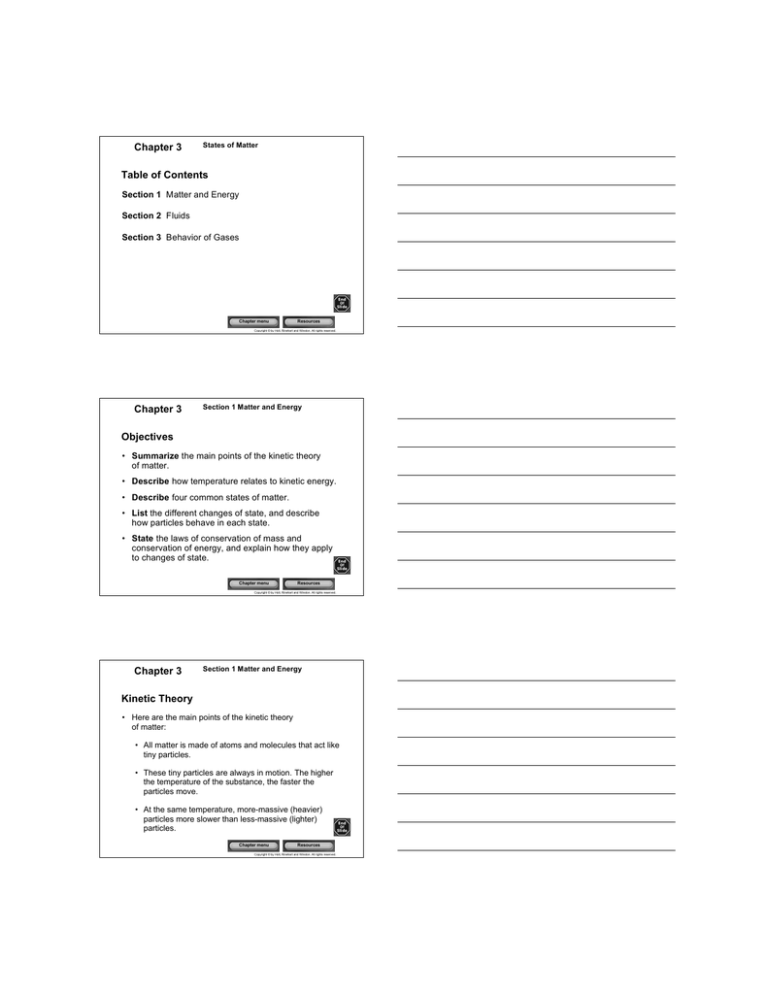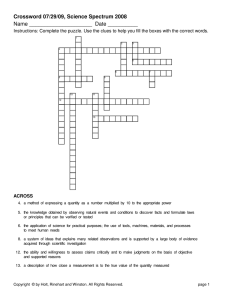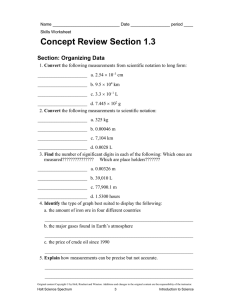
Chapter 3
States of Matter
Table of Contents
Section 1 Matter and Energy
Section 2 Fluids
Section 3 Behavior of Gases
Chapter menu
Resources
Copyright © by Holt, Rinehart and Winston. All rights reserved.
Chapter 3
Section 1 Matter and Energy
Objectives
• Summarize the main points of the kinetic theory
of matter.
• Describe how temperature relates to kinetic energy.
• Describe four common states of matter.
• List the different changes of state, and describe
how particles behave in each state.
• State the laws of conservation of mass and
conservation of energy, and explain how they apply
to changes of state.
Chapter menu
Resources
Copyright © by Holt, Rinehart and Winston. All rights reserved.
Chapter 3
Section 1 Matter and Energy
Kinetic Theory
• Here are the main points of the kinetic theory
of matter:
• All matter is made of atoms and molecules that act like
tiny particles.
• These tiny particles are always in motion. The higher
the temperature of the substance, the faster the
particles move.
• At the same temperature, more-massive (heavier)
particles more slower than less-massive (lighter)
particles.
Chapter menu
Resources
Copyright © by Holt, Rinehart and Winston. All rights reserved.
Chapter 3
Section 1 Matter and Energy
Kinetic Theory, continued
• The states of matter differ physically from
one another.
• Particles of a solid, such as iron, are in fixed
positions.
• In a liquid, such as cooking oil, the particles are
closely packed, but they can slide past each other.
• Gas particles are in a constant state of motion
and rarely stick together.
Chapter menu
Resources
Copyright © by Holt, Rinehart and Winston. All rights reserved.
Chapter 3
Section 1 Matter and Energy
States of Matter
Chapter menu
Resources
Copyright © by Holt, Rinehart and Winston. All rights reserved.
Chapter 3
Section 1 Matter and Energy
Kinetic Theory, continued
• Solids have a definite shape and volume.
• The structure of a solid is rigid, and the particles have
almost no freedom to change position.
• Crystalline solids have an orderly arrangement of
atoms or molecules.
• Amorphous solids are composed of atoms or
molecules that are in no particular order.
Chapter menu
Resources
Copyright © by Holt, Rinehart and Winston. All rights reserved.
Chapter 3
Section 1 Matter and Energy
Kinetic Theory, continued
• Liquids change shape, but not volume.
• The particles in a liquid move more rapidly than
those of a solid—fast enough to overcome the forces
of attraction between them.
• The particles in a liquid can slide past each other,
flowing freely. Liquids can take the shape of the
container they are put into.
• Liquids have surface tension, the force acting at the
surface of a liquid that causes a liquid, such as
water, to form spherical drops.
Chapter menu
Resources
Copyright © by Holt, Rinehart and Winston. All rights reserved.
Chapter 3
Section 1 Matter and Energy
Liquid
Chapter menu
Resources
Copyright © by Holt, Rinehart and Winston. All rights reserved.
Chapter 3
Section 1 Matter and Energy
Kinetic Theory, continued
• Gases are free to spread in all directions.
• The particles of a gas move fast enough to break
away from each other.
• The space between gas particles can change, so
a gas expands to fill the available space.
• A gas can also be compressed to a
smaller volume.
Chapter menu
Resources
Copyright © by Holt, Rinehart and Winston. All rights reserved.
Chapter 3
Section 1 Matter and Energy
Gas
Chapter menu
Resources
Copyright © by Holt, Rinehart and Winston. All rights reserved.
Chapter 3
Section 1 Matter and Energy
Kinetic Theory, continued
• Plasma is the most common state of matter.
• Plasma is a state of matter that starts as a gas
and then becomes ionized.
• Plasmas conduct electric current, while gases
do not.
• Natural plasmas are found in lightning and fire.
The glow of a fluorescent light is caused by an
artificial plasma, created by passing electric
currents through gases.
Chapter menu
Resources
Copyright © by Holt, Rinehart and Winston. All rights reserved.
Chapter 3
Section 1 Matter and Energy
Energy’s Role
• Energy is the capacity to do work.
• Sources of energy can include:
• electricity, candles, and batteries
• the food you eat
• chemical reactions that release heat
Chapter menu
Resources
Copyright © by Holt, Rinehart and Winston. All rights reserved.
Chapter 3
Section 1 Matter and Energy
Energy’s Role, continued
• According to the kinetic theory, all matter is made of
particles that are constantly in motion.
• Because the particles are in motion, they have
kinetic energy, or energy of motion.
• Thermal energy is the total kinetic energy of a
substance.
• The more kinetic energy the particles in the object
have, the more thermal energy the object has.
Chapter menu
Resources
Copyright © by Holt, Rinehart and Winston. All rights reserved.
Chapter 3
Section 1 Matter and Energy
Energy’s Role, continued
• Temperature is a measure of average kinetic energy.
• Unlike total kinetic energy, temperature does not
depend on how much of the substance you have.
• For example, a teapot contains more tea than a
mug does, but the temperature, or average kinetic
energy of the particles in the tea, is the same in
both containers.
Chapter menu
Resources
Copyright © by Holt, Rinehart and Winston. All rights reserved.
Chapter 3
Section 1 Matter and Energy
Energy and Changes of State
• A change of state—the conversion of a substance
from one physical form to another—is a
physical change.
• The identity of a substance does not change during
a change of state, but the energy of a substance
does change.
• A transfer of energy known as heat causes the
temperature of a substance to change, which can
lead to a change of state.
Chapter menu
Resources
Copyright © by Holt, Rinehart and Winston. All rights reserved.
Chapter 3
Section 1 Matter and Energy
States of Matter
Chapter menu
Resources
Copyright © by Holt, Rinehart and Winston. All rights reserved.
Chapter 3
Section 1 Matter and Energy
Energy and Changes of State, continued
• Some changes of state require energy.
• Evaporation is the change of a substance from a
liquid to a gas. Energy is needed to separate the
particles of a liquid to form a gas.
• Sublimation is the process by which a solid turns
directly to a gas. Sometimes ice sublimes to form
a gas.
Chapter menu
Resources
Copyright © by Holt, Rinehart and Winston. All rights reserved.
Chapter 3
Section 1 Matter and Energy
Energy and Changes of State, continued
• Energy is released in some changes of state.
• Condensation is the change of a substance from
a gas to a liquid. Energy is released from the gas
and the particles slow down.
• Energy is also released during freezing, which is
the change of state from a liquid to a solid.
• When a substance loses or gains energy, either
its temperature changes or its state changes, but
not both.
Chapter menu
Resources
Copyright © by Holt, Rinehart and Winston. All rights reserved.
Chapter 3
Section 1 Matter and Energy
Conservation of Mass and Energy
• The law of conservation of mass says that
mass cannot be created or destroyed.
• For instance, when you burn a match, the total
mass of the reactants (the match and oxygen)
is the same as the total mass of the products
(the ash, smoke, and gases).
• The law of conservation of energy states that
energy cannot be created or destroyed.
• For instance, when you drive a car, gasoline
releases its stored energy, in the form of heat,
used to move the car.
Chapter menu
Resources
Copyright © by Holt, Rinehart and Winston. All rights reserved.
Chapter 3
Section 2 Fluids
Objectives
• Describe the buoyant force and explain how it keeps
objects afloat.
• Define Archimedes’ principle.
• Explain the role of density in an object’s ability to
float.
• State and apply Pascal’s principle.
• State and apply Bernoulli’s principle.
Chapter menu
Resources
Copyright © by Holt, Rinehart and Winston. All rights reserved.
Chapter 3
Section 2 Fluids
Fluids
• A fluid is a nonsolid state of matter in which the
atoms or molecules are free to move past each other,
as in a gas or liquid.
• Fluids are able to flow because their particles can
move past each other easily.
• The properties of fluids allow huge ships to float,
divers to explore the ocean depths, and jumbo jets
to soar across the skies.
Chapter menu
Resources
Copyright © by Holt, Rinehart and Winston. All rights reserved.
Chapter 3
Section 2 Fluids
Fluid
Chapter menu
Resources
Copyright © by Holt, Rinehart and Winston. All rights reserved.
Chapter 3
Section 2 Fluids
Buoyant Force
• Buoyant force is the upward force exerted on an
object immersed in or floating on a fluid.
• Buoyancy explains why objects float.
• All fluids exert pressure: the amount of force
exerted per unit area of a surface.
• Archimedes’ principle states that the buoyant
force on an object in a fluid is an upward force
equal to the weight of the volume of fluid that the
object displaces.
Chapter menu
Resources
Copyright © by Holt, Rinehart and Winston. All rights reserved.
Chapter 3
Section 2 Fluids
Buoyant Force, continued
• The volume of fluid displaced by an object placed in a
fluid will be equal to the volume of the part of the
object submerged.
• The figure below shows how displacement works.
Chapter menu
Resources
Copyright © by Holt, Rinehart and Winston. All rights reserved.
Chapter 3
Section 2 Fluids
Buoyant Force, continued
• An object will float or sink based on its density.
• If an object is less dense than the fluid in which it
is placed, it will float.
• If an object is more dense than the fluid in which it
is placed, it will sink.
Chapter menu
Resources
Copyright © by Holt, Rinehart and Winston. All rights reserved.
Chapter 3
Section 2 Fluids
Density
Chapter menu
Resources
Copyright © by Holt, Rinehart and Winston. All rights reserved.
Chapter 3
Section 2 Fluids
Fluids and Pressure
• Fluids exert pressure evenly in all directions.
• For example, when you pump up a bicycle tire, air
particles are constantly pushing against each
other and against the walls of the tire.
Chapter menu
Resources
Copyright © by Holt, Rinehart and Winston. All rights reserved.
Chapter 3
Section 2 Fluids
Fluids and Pressure, continued
• Pressure can be calculated by dividing force by the
area over which the force is exerted:
• The SI unit for pressure is the pascal (abbreviation:
Pa), equal to the force of one newton exerted over an
area of one square meter (1 N/m2).
Chapter menu
Resources
Copyright © by Holt, Rinehart and Winston. All rights reserved.
Chapter 3
Section 2 Fluids
Pascal’s Principle
• Pascal’s principle states that a fluid in equilibrium
contained in a vessel exerts a pressure of equal
intensity in all directions.
• Mathematically, Pascal’s principle is stated as
p1 = p 2 , or pressure1 = pressure2 .
Chapter menu
Resources
Copyright © by Holt, Rinehart and Winston. All rights reserved.
Chapter 3
Section 2 Fluids
Math Skills
Pascal’s Principle A hydraulic lift, shown in the figure
below, makes use of Pascal’s principle, to lift a
19,000 N car. If the area of the small piston (A1)
equals 10.5 cm2 and the area of the large piston (A2)
equals 400 cm2 , what force needs to be exerted on
the small piston to lift the car?
Chapter menu
Resources
Copyright © by Holt, Rinehart and Winston. All rights reserved.
Chapter 3
Section 2 Fluids
Math Skills, continued
1. List the given and unknown values.
Given:
F 2 = 19,000 N
A 1 = 10.5 cm2
A 2 = 400 cm2
Unknown: F 1
2. Write the equation for Pascal’s principle.
According to Pascal’s principle, p1 = p 2.
Chapter menu
Resources
Copyright © by Holt, Rinehart and Winston. All rights reserved.
Chapter 3
Section 2 Fluids
Math Skills, continued
3. Insert the known values into the equation,
and solve.
F1 = 500 N
Chapter menu
Resources
Copyright © by Holt, Rinehart and Winston. All rights reserved.
Chapter 3
Section 2 Fluids
Pascal’s Principle, continued
• Hydraulic devices are based on Pascal’s principle.
• Hydraulic devices can multiply forces, as shown in
the figure below. Because the pressure is the
same on both sides of the enclosed fluid, a small
force on the smaller area (at left) produces a much
larger force on the larger area (at right).
Chapter menu
Resources
Copyright © by Holt, Rinehart and Winston. All rights reserved.
Chapter 3
Section 2 Fluids
Fluids in Motion
• Viscosity is the resistance of a gas or liquid to flow.
• Bernoulli’s principle states that as the speed of a
moving fluid increases, the pressure of the moving
fluid decreases.
• Bernoulli’s principle is illustrated below: as a leaf
passes through a drainage pipe from point 1 to
point 2, it speeds up, and the water pressure
decreases.
Chapter menu
Resources
Copyright © by Holt, Rinehart and Winston. All rights reserved.
Chapter 3
Section 3 Behavior of Gases
Objectives
• Explain how gases differ from solids and liquids.
• State and explain the following gas laws: Boyle’s law,
Charles’s law, and Gay-Lussac’s law.
• Describe the relationship between gas pressure,
temperature and volume.
Chapter menu
Resources
Copyright © by Holt, Rinehart and Winston. All rights reserved.
Chapter 3
Section 3 Behavior of Gases
Properties of Gases
• Gases have unique properties. Some important
properties of gases are listed below.
• Gases have no definite shape or volume, and they
expand to completely fill their container.
• Gas particles move rapidly in all directions.
• Gases spread out easily and mix with one another.
Unlike solids and liquids, gases are mostly empty
space.
Chapter menu
Resources
Copyright © by Holt, Rinehart and Winston. All rights reserved.
Chapter 3
Section 3 Behavior of Gases
Properties of Gases, continued
• (some important gas properties, continued)
• Gases have a very low density because their
particles are so far apart. Because of this property,
gases are used to inflate tires and balloons.
• Gases are compressible.
• Gases are fluids.
• Gas molecules are in constant motion, and they
frequently collide with one another and with the
walls of their container.
Chapter menu
Resources
Copyright © by Holt, Rinehart and Winston. All rights reserved.
Chapter 3
Section 3 Behavior of Gases
Properties of Gases, continued
• Gases exert pressure on their containers.
• The kinetic theory helps to explain pressure. Helium
atoms in a balloon are constantly hitting each other
and the walls of the balloon, as shown below.
• Therefore, if the balloon is punctured, the gas will
escape with a lot of force, causing the balloon to pop.
Chapter menu
Resources
Copyright © by Holt, Rinehart and Winston. All rights reserved.
Chapter 3
Section 3 Behavior of Gases
Gas Laws
• Boyle’s law states that for a fixed amount of gas at a
constant temperature, the volume of the gas
decreases its pressure increases. Likewise, the
volume of a gas increases as its pressure decreases.
• Boyle’s law can be expressed mathematically as:
(pressure1 )(volume1 ) = (pressure2 )(volume2 ) ,
or P1 V1 = P2V 2
Chapter menu
Resources
Copyright © by Holt, Rinehart and Winston. All rights reserved.
Chapter 3
Section 3 Behavior of Gases
Boyle’s Law
Chapter menu
Resources
Copyright © by Holt, Rinehart and Winston. All rights reserved.
Chapter 3
Section 3 Behavior of Gases
Math Skills
Boyle’s Law The gas in a balloon has a volume of
7.5 L at 100 kPa. The balloon is released into the
atmosphere, and the gas expands to a volume of
11 L. Assuming a constant temperature, what is the
pressure on the balloon at the new volume?
1. List the given and unknown values.
Given:
V 1 = 7.5 L
P 1 = 100 kPa
V 2 = 11 L
Unknown: P 2
Chapter menu
Resources
Copyright © by Holt, Rinehart and Winston. All rights reserved.
Chapter 3
Section 3 Behavior of Gases
Math Skills, continued
2. Write the equation for Boyle’s law, and rearrange
the equation to solve for P2.
P1V1 = P2 V2
3. Insert the known values into the equation,
and solve.
P2 = 68 kPa
Chapter menu
Resources
Copyright © by Holt, Rinehart and Winston. All rights reserved.
Chapter 3
Section 3 Behavior of Gases
Gas Laws, continued
• Charles’s law states that for a fixed amount of gas at
a constant pressure, the volume of the gas increases
as its temperature increase. Likewise, the volume of a
gas decreases as its temperature decreases.
• As shown below, if the gas in an inflated balloon is
cooled (at constant pressure), the gas will decrease
in volume and cause the balloon to deflate.
Chapter menu
Resources
Copyright © by Holt, Rinehart and Winston. All rights reserved.
Chapter 3
Section 3 Behavior of Gases
Charles’s Law
Chapter menu
Resources
Copyright © by Holt, Rinehart and Winston. All rights reserved.
Chapter 3
Section 3 Behavior of Gases
Gas Laws, continued
• Gay-Lussac’s law states that the pressure of a gas
increases as the temperature increases if the volume
of the gas does not change.
• This is why, if a pressurized container that holds
gas, such as a spray can, is heated, it may
explode.
Chapter menu
Resources
Copyright © by Holt, Rinehart and Winston. All rights reserved.





